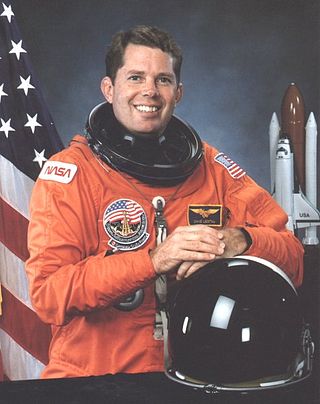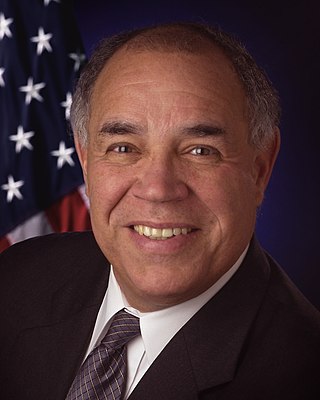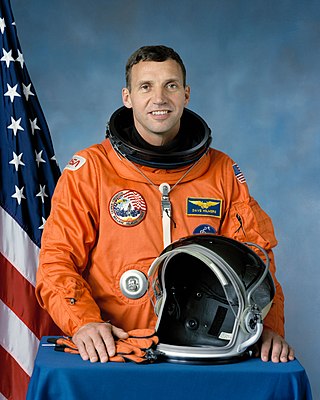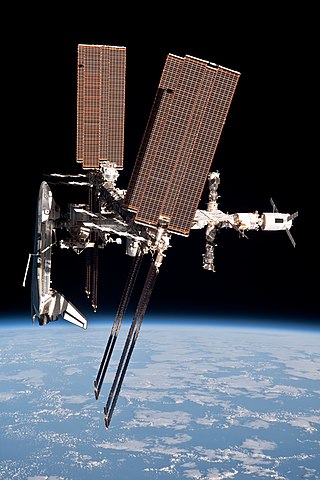
Space Shuttle Columbia (OV-102) was a Space Shuttle orbiter manufactured by Rockwell International and operated by NASA. Named after the first American ship to circumnavigate the upper North American Pacific coast and the female personification of the United States, Columbia was the first of five Space Shuttle orbiters to fly in space, debuting the Space Shuttle launch vehicle on its maiden flight in April 1981. As only the second full-scale orbiter to be manufactured after the Approach and Landing Test vehicle Enterprise, Columbia retained unique features indicative of its experimental design compared to later orbiters, such as test instrumentation and distinctive black chines. In addition to a heavier fuselage and the retention of an internal airlock throughout its lifetime, these made Columbia the heaviest of the five spacefaring orbiters; around 1,000 kilograms heavier than Challenger and 3,600 kilograms heavier than Endeavour. Columbia also carried ejection seats based on those from the SR-71 during its first six flights until 1983, and from 1986 onwards carried an imaging pod on its vertical stabilizer.

Space Shuttle Atlantis is a retired Space Shuttle orbiter vehicle which belongs to NASA, the spaceflight and space exploration agency of the United States. Atlantis was manufactured by the Rockwell International company in Southern California and was delivered to the Kennedy Space Center in Eastern Florida in April 1985. Atlantis is also the fourth operational and the second-to-last Space Shuttle built. Its maiden flight was STS-51-J made from October 3 to 7, 1985.

STS-41-D was the 12th flight of NASA's Space Shuttle program, and the first mission of Space Shuttle Discovery. It was launched from Kennedy Space Center, Florida, on August 30, 1984, and landed at Edwards Air Force Base, California, on September 5, 1984. Three commercial communications satellites were deployed into orbit during the six-day mission, and a number of scientific experiments were conducted, including a prototype extendable solar array that would eventually form the basis of the main solar arrays on the International Space Station (ISS).

STS-61-A was the 22nd mission of NASA's Space Shuttle program. It was a scientific Spacelab mission, funded and directed by West Germany – hence the non-NASA designation of D-1. STS-61-A was the ninth and last successful flight of Space Shuttle Challenger before the disaster. STS-61-A holds the current record for the largest crew—eight people—aboard any single spacecraft for the entire period from launch to landing.

Richard Michael Mullane is an engineer and weapon systems officer, a retired USAF officer, and a former NASA astronaut. During his career, he flew as a mission specialist on STS-41-D, STS-27, and STS-36.

Frederick Hamilton "Rick" Hauck is a retired captain in the United States Navy, a former fighter pilot and NASA astronaut. He piloted Space Shuttle mission STS-7 and commanded STS-51-A and STS-26.

David Cornell Leestma is a former American astronaut and retired Captain in the United States Navy.

Charles Frank Bolden Jr. is a former Administrator of NASA, a retired United States Marine Corps Major General, and a former astronaut who flew on four Space Shuttle missions.

Richard James Hieb is a former NASA astronaut and a veteran of three Space Shuttle missions. He was a mission specialist on STS-39 and STS-49, and was a payload commander on STS-65. After leaving NASA he worked at AlliedSignal and Orbital before spending 14 years as an executive at Lockheed Martin. He is currently a faculty member in the University of Colorado Boulder Smead Aerospace Engineering Sciences Department.

Ellen Louise Shulman Baker, M.D., M.P.H. is an American physician and a former NASA astronaut. Baker is a veteran of three shuttle flights and logged more than 686 hours in space. Baker served as Chief of the Education/Medical Branch of the NASA Astronaut Office until her retirement in 2011 after more than 30 years of service to NASA.

Michael Allen Baker is a retired captain in the United States Navy, former NASA astronaut, and the International Space Station Program Manager for International and Crew Operations, at NASA's Johnson Space Center. He is responsible for the coordination of program operations, integration and flight crew training and support activities with the International Partners.

Robert Joseph "Bob" Cenker is an American aerospace and electrical engineer, aerospace systems consultant, and former astronaut. Cenker worked for 18 years at RCA Astro-Electronics, and its successor company GE Astro Space, on a variety of spacecraft projects. He spent most of his career working on commercial communications satellites, including the Satcom, Spacenet and GStar programs.

Charles Donald "Sam" Gemar is an American former astronaut with NASA and a lieutenant colonel in the United States Army. Gemar has flown on three Space Shuttle missions. Gemar has completed 385 orbits of the Earth and over 581 hours in space. He has also served in different positions in NASA, including as a CAPCOM for Shuttle missions. Gemar was the first astronaut to be born in the state of South Dakota.

Frederick Drew Gregory is a former United States Air Force pilot, military engineer, test pilot, and NASA astronaut as well as former NASA Deputy Administrator. He also served briefly as NASA Acting Administrator in early 2005, covering the period between the departure of Sean O'Keefe and the swearing in of Michael D. Griffin.

David Carl Hilmers is a former NASA astronaut who flew four Space Shuttle missions. He was born in Clinton, Iowa, but considers DeWitt, Iowa, to be his hometown. He has two grown sons. His recreational interests include playing the piano, gardening, electronics, spending time with his family, and all types of sports. His parents are deceased. With five academic degrees, he is the second most formally educated U.S. astronaut, behind Story Musgrave with six.

George David Low was an American aerospace executive and a NASA astronaut. With undergraduate degrees in physics and mechanical engineering and a master's degree in aeronautics and astronautics, he worked in the Jet Propulsion Laboratory (JPL) at the California Institute of Technology in the early 80's, before being picked as an astronaut candidate by NASA in 1984. In addition to holding some technical assignments, he logged more than 700 hours in space, before he left NASA in 1996 to pursue a career in the private sector. He was the son of George M. Low, the manager of the Apollo Spacecraft Program Office, and later, the 14th president of Rensselaer Polytechnic Institute.

Bruce Edward Melnick is a retired American astronaut and United States Coast Guard officer. Following retirement from NASA and the Coast Guard, he entered the aerospace industry. He served as a vice president with the Boeing Co.'s Integrated Defense Systems group, in charge of Boeing's Florida operations at the John F. Kennedy Space Center (KSC). Melnick retired in 2008 and currently resides on Merritt Island, Florida.

STS-51-L was the 25th mission of NASA's Space Shuttle program and the final flight of Space Shuttle Challenger.

Joan Elizabeth Higginbotham is an electrical engineer and a former NASA astronaut. She flew aboard Space Shuttle Discovery mission STS-116 as a mission specialist and is the third African American woman to go into space, after Mae Jemison and Stephanie Wilson.

STS-134 was the penultimate mission of NASA's Space Shuttle program and the 25th and last spaceflight of Space ShuttleEndeavour. This flight delivered the Alpha Magnetic Spectrometer and an ExPRESS Logistics Carrier to the International Space Station. Mark Kelly served as the mission commander. STS-134 was expected to be the final Space Shuttle mission if STS-135 did not receive funding from Congress. However, in February 2011, NASA stated that STS-135 would fly "regardless" of the funding situation. STS-135, flown by Atlantis, took advantage of the processing for STS-335, the Launch on Need mission that would have been necessary if the STS-134 crew became stranded in orbit.




















